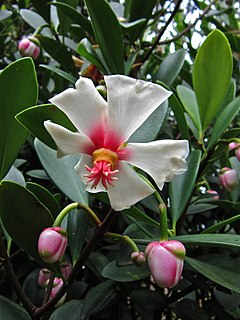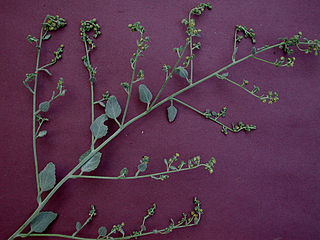Ophellantha is a genus of plants under the family Euphorbiaceae first described as a genus in 1924. It is native to southern Mexico and northern Central America.
- Ophellantha spinosaStandl. - Honduras, El Salvador, Chiapas, Veracruz
- Ophellantha steyermarkiiStandl. - Guatemala, Chiapas

Paul Carpenter Standley was an American botanist.

Dicoria (twinbugs) is a genus of North American flowering plants in the sunflower tribe within the daisy family, native to the southwestern United States and northwestern Mexico.

Yucca baileyi is a plant in the family Agavaceae. It is native to Utah, Arizona, New Mexico and Colorado but has been cultivated elsewhere. Much of its native range is within the boundaries of the Navajo (Diné) Reservation, hence the common name "Navajo yucca." The Navajo people make extensive use of yucca fibers to make a wide assortment of useful and ceremonial items. They also use the roots as soap.

Mahonia gracilis is a plant species native to the Mexico, widely distributed from Tamaulipas to Oaxaca.
Berberis trifolia is a shrub in the Berberidaceae described as a species in 1830. It is endemic to Mexico, known from the states of Hidalgo, Mexico, and Veracruz.
Berberis angustifolia is a shrub in the family Berberidaceae, first described as a species in 1840.

Berberis tenuifolia is a shrub in the family Berberidaceae described as a species in 1838. It is native to Cuba and Mexico.
Berberis lanceolata is a shrub in the Berberidaceae described as a species in 1840. It is endemic to Mexico, found in the States of Hidalgo, Oaxaca, Veracruz, and Puebla.
Berberis hartwegii is a shrub in the Berberidaceae described as a species in 1840. It is endemic to Mexico, found in the States of Hidalgo, San Luis Potosí, and Tamaulipas.
Berberis ilicina is a shrub in the Berberidaceae described as a species in 1836. It is endemic to northeastern Mexico, found in the States of Hidalgo and Tamaulipas.
Berberis andrieuxii is a shrub in the Berberidaceae described as a species in 1838. It is endemic to the State of Oaxaca in southern Mexico.
Berberis pallida is a shrub in the Berberidaceae described as a species in 1840. It is endemic to Mexico, known from the States of Guanajuato, Hidalgo, Oaxaca, Veracruz, Puebla, Querétaro, and Tamaulipas.
Berberis pallida is a shrub in the Berberidaceae described as a species in 1901. It is endemic to the State of Hidalgo in eastern Mexico.
Mahonia zimapana is a shrub in the Berberidaceae described as a species in 1901. It is an uncommon species native to the States of Mexico and Hidalgo in Mexico.
Odostemon quinquefolius is a shrub in the family Berberidaceae described as a species in 1918. This name is accepted by The Plant List. The species is endemic to Mexico, reported from the States of Puebla and Durango.
Brickellia chenopodina is a North American species of flowering plants in the daisy family. It is native to Grant County in New Mexico.
Lorandersonia baileyi, is a North American species of flowering plants in the aster tribe within the sunflower family. It was initially discovered in the Guadalupe Mountains of New Mexico in 1902, and has since been collected in Arizona, Utah, Colorado, Kansas, Oklahoma, Texas, Chihuahua, Coahuila, and Nuevo León.
Erigeron aquarius is a Central American species of flowering plant in the daisy family. It has been found only in Guatemala and Honduras. The type specimen was collected in Guatemala in 1939.




